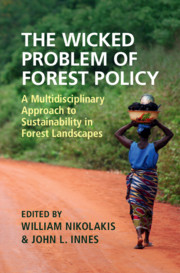 The Wicked Problem of Forest Policy
The Wicked Problem of Forest Policy Book contents
- The Wicked Problem of Forest Policy
- The Wicked Problem of Forest Policy
- Copyright page
- Contents
- Contributors
- 1 The Wicked Problem of Forest Policy
- Part I Wicked Problems and Policies
- 2 Why Forests Matter?
- 3 Forest Certification and Forest Use
- 4 REDD+ Meets Local Realities
- 5 Have Payments for Ecosystem Services Delivered for the Rural Poor?
- 6 Tackling Gender Inequality through Forest-Related Policies and Programmes
- 7 Forestry Crimes and Our Planet
- 8 Forest Bioeconomy Development
- Part II Tools to Address Wicked Problems
- Index
- References
3 - Forest Certification and Forest Use
A Comprehensive Analysis
from Part I - Wicked Problems and Policies
Published online by Cambridge University Press: 24 July 2020
- The Wicked Problem of Forest Policy
- The Wicked Problem of Forest Policy
- Copyright page
- Contents
- Contributors
- 1 The Wicked Problem of Forest Policy
- Part I Wicked Problems and Policies
- 2 Why Forests Matter?
- 3 Forest Certification and Forest Use
- 4 REDD+ Meets Local Realities
- 5 Have Payments for Ecosystem Services Delivered for the Rural Poor?
- 6 Tackling Gender Inequality through Forest-Related Policies and Programmes
- 7 Forestry Crimes and Our Planet
- 8 Forest Bioeconomy Development
- Part II Tools to Address Wicked Problems
- Index
- References
Summary
Forest certification, developed in 1993, is one means to resolve wicked forestry problems. This non-state market-driven process was highly anticipated to succeed in improving forest management, sustainability and governance, where regulation had fallen short. Forest certification has had substantial accomplishments and this chapter compares and analyses the two competing global forest certification schemes, the Forest Stewardship Council (FSC) and the Programme for the Endorsement of Forest Certification.
Keywords
- Type
- Chapter
- Information
- The Wicked Problem of Forest PolicyA Multidisciplinary Approach to Sustainability in Forest Landscapes, pp. 59 - 107Publisher: Cambridge University PressPrint publication year: 2020


